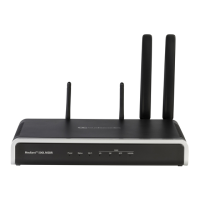User's Manual 192 Document #: LTRT-10466
Mediant 500L MSBR
Supported: em,100rel,timer,replaces,path,resource-priority,sdp-
anat
Allow:
REGISTER,OPTIONS,INVITE,ACK,CANCEL,BYE,NOTIFY,PRACK,REFER,INFO,SUB
SCRIBE,UPDATE
Remote-Party-ID:
<sip:318@10.8.211.250>;party=calling;privacy=off;screen=no;screen-
ind=0;npi=1;ton=0
Remote-Party-ID: <sip:2001@10.8.211.250>;party=called;npi=1;ton=0
User-Agent: Audiocodes-Sip-Gateway-/v.6.80A.227.005
Content-Type: application/sdp
Content-Length: 433
v=0
o=AudiocodesGW 1938931006 1938930708 IN IP4 10.8.6.55
s=Phone-Call
c=IN IP4 10.8.6.55
t=0 0
m=audio 6010 RTP/AVP 18 97
a=rtpmap:18 G729/8000
a=fmtp:18 annexb=no
a=rtpmap:97 telephone-event/8000
a=fmtp:97 0-15
a=ptime:20
a=sendrecv
m=image 6012 udptl t38
a=T38FaxVersion:3
a=T38MaxBitRate:33600
a=T38FaxMaxBuffer:1024
a=T38FaxMaxDatagram:122
a=T38FaxRateManagement:transferredTCF
a=T38FaxUdpEC:t38UDPRedundancy
17.2.4 V.150.1 Modem Relay
The device can be configured to transfer modem calls using a subset of the ITU-T V.150.1
Modem Relay protocol. The device also supports V.150.1 modem relay coder negotiation
in the initial SIP INVITE and 200 OK, using the SDP body according to the USA
Department of Defense (DoD) UCR-2008, Change 2 specification. This eliminates the need
for sending a re-INVITE to negotiate V.150.1. The device sends an INVITE’s SDP offer in a
format to negotiate V.150 modem relay using the same port as RTP, as shown in the
example below:
a=cdsc:1 audio udpsprt 114\r\n
a=cpar:a=sprtmap:114 v150mr/8000\r\n
a=cpar:a=fmtp:114
mr=1;mg=0;CDSCselect=1;mrmods=1,3;jmdelay=no;versn=1.1\r\n\
You can configure the payload type for the outgoing SDP offer, using the
NoAudioPayloadType parameter. You can set this parameter to "NoAudio", whereby RTP
is not sent and the device adds an audio media only for the Modem Relay purpose. This is
also in accordance to DOD UCR 2008 specification: "The AS-SIP signaling appliance
MUST advertise the “NoAudio” payload type to interoperate with a “Modem Relay-
Preferred” endpoint that immediately transitions to the Modem Relay state without first
transmitting voice information in the Audio state."

